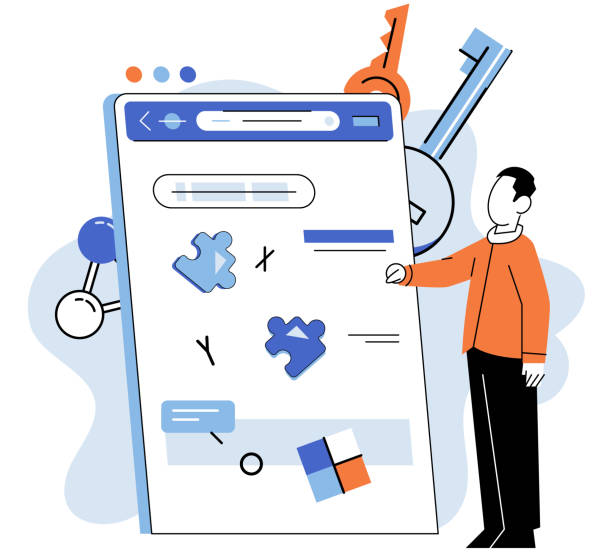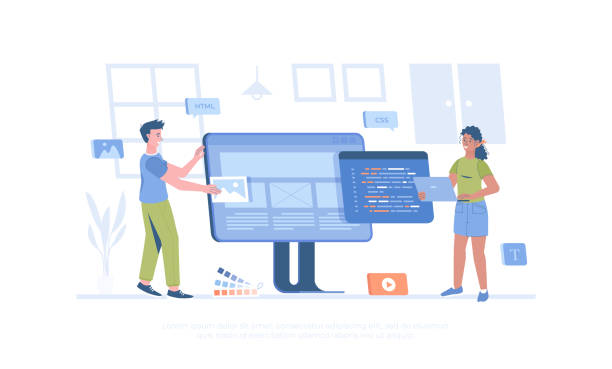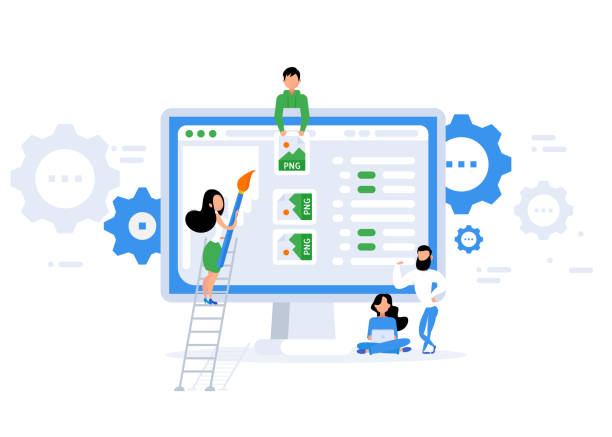Introduction to Fast Website Design: Why Speed Matters?

In today’s digital world, speed is a critical factor for the success of any business.
Fast website design is no longer a luxury option, but an undeniable necessity.
When a user enters your website, the first thing they experience is page loading speed.
If your website is slow, the user will likely leave the page before seeing your valuable content.
This not only harms #User_Experience but also negatively impacts your ranking in search engines.
Studies have shown that even a one-second delay in page loading can lead to a significant decrease in conversions and customer satisfaction.
Therefore, the importance of #Website_Speed_Optimization cannot be underestimated.
Our goal with fast website design is to provide an unparalleled user experience that keeps users satisfied and helps your business achieve its commercial goals.
In the rest of this article, we will delve deeper into various aspects of SEO and other factors influencing website loading speed.
Disappointed with your online store’s low conversion rate? Rasaweb transforms your online store into a powerful tool for attracting and converting customers!
✅ Significantly increase visitor-to-buyer conversion rates
✅ Unparalleled user experience to boost customer satisfaction and loyalty⚡ Get a free consultation from Rasaweb!
Technical Factors Affecting Website Speed: In-depth Analysis

To achieve fast website design, we must consider several technical factors.
These factors include server infrastructure, code optimization, and compression of images and other resources.
One of the most important is hosting quality and server; a slow server or one with limited resources can nullify all your optimization efforts.
Using dedicated servers or VPS with sufficient resources, as well as choosing a data center close to the target audience, plays a significant role in reducing server response time.
Furthermore, #Website_Code_Optimization is of high importance.
CSS and JavaScript code should be minified and, if possible, #Excess_Website_Files should be reduced.
Merging smaller CSS and JS files into one larger file can decrease the number of HTTP requests and help with faster loading.
Images are also key factors; using optimized formats like WebP and compressing images without losing quality significantly impacts page loading speed.
Database optimization, removing unnecessary plugins, and enabling caching are among the specialized solutions that contribute to fast website design and can make a big difference in your website’s performance.
User Experience and Website Speed: An Inseparable Connection

Website speed is directly linked to #User_Experience (UX) and consequently to conversion rates.
A slow website can frustrate users and deter them from continuing to browse your site.
This issue not only negatively impacts your brand but can also lead to the loss of potential customers.
Research shows that most users expect a web page to load in less than 2 to 3 seconds; any further delay can lead to an increased Bounce Rate.
Fast website design essentially means providing a smooth and unhindered path for the user to access the information or services they desire.
When your site is fast, users are more inclined to stay, explore content, and ultimately perform your desired actions (such as purchasing or registering).
This means increased #Customer_Satisfaction and ultimately improved business performance.
Therefore, paying attention to #Website_Speed_Optimization to enhance UX is considered a smart investment.
To clarify this connection, the table below shows the impact of loading speed on key UX metrics:
| Page Load Time | Impact on Bounce Rate | Impact on Conversion | Impact on User Satisfaction |
|---|---|---|---|
| 1 second | Lowest | Highest | Very High |
| 3 seconds | 32% increase | 10-15% decrease | Medium |
| 5 seconds | 90% increase | 20-30% decrease | Low |
Website Speed Measurement Tools: A Comprehensive Guide

To ensure your website functions correctly and meets the fast website design criterion, using reliable speed measurement tools is essential.
These tools help you identify performance bottlenecks and provide appropriate solutions for speed improvement.
One of the most widely used tools is #Google_PageSpeed_Insights, provided by Google, which shows important metrics such as #Performance_Score for mobile and desktop, along with suggestions for improvement.
This tool is particularly important for SEO, as its metrics are directly related to Google’s ranking algorithms.
Another tool is #GTmetrix, which provides comprehensive reports on your website’s performance, including full load time, page size, and the number of requests, and offers more detailed optimization suggestions.
Lighthouse, an open-source, automated tool for improving web page quality, allows for comprehensive analysis of performance, accessibility, best practices, and SEO directly within the Chrome browser.
Regular use of these tools and continuous monitoring of website speed helps you always stay on the path of continuous speed optimization and stay ahead of competitors.
This is an #educational and #guidance approach for maintaining a high-performance website.
Are you losing business opportunities because of an outdated website? With Rasaweb, permanently solve the problem of not attracting potential customers through your website!
✅ Attract more high-quality leads
✅ Increase brand credibility in the eyes of customers⚡ Get a free corporate website design consultation!
Client-Side Optimization for Fast Website Design: Tips for Developers

Client-side optimization (Front-end Optimization) plays a very important role in achieving fast website design.
This section includes all actions performed in the user’s browser to load and display web pages faster.
One of the main methods is #CSS_and_JavaScript_Minification, which reduces file sizes by removing extra characters such as whitespace and comments.
Additionally, #File_Concatenation helps reduce the number of HTTP requests; the fewer requests the browser needs, the faster it can render the page.
Using a Content Delivery Network (CDN) is also a powerful strategy.
A CDN caches your website’s content on various geographical servers, ensuring that users receive content from the server closest to them, which significantly reduces latency.
#Lazy_Loading_Images is another effective technique that loads images and videos only when the user scrolls towards them, reducing initial page load.
These techniques, along with font optimization and using browser caching, greatly assist you in achieving a very fast and responsive website.
This #specialized knowledge is crucial for any developer aiming for fast website design.
Server-Side Optimization for Higher Performance: Specialized Solutions

Server-side optimization (Back-end Optimization) is one of the fundamental pillars for achieving fast website design that is often overlooked.
This includes all actions performed on your website’s host server to process and respond to user requests faster.
One of the most important aspects is #Database_Optimization.
Large and unoptimized databases can significantly increase server response time.
Using appropriate indexes, optimizing queries, and deleting old and unnecessary data can improve database performance.
Also, Server-side_Caching is a very effective solution.
This method involves storing pre-generated versions of pages or query results in server memory so that subsequent requests do not require reprocessing.
This significantly reduces server response time and contributes to fast website design.
Using optimized and lightweight APIs is also essential to ensure fast data exchange between the server and client.
Finally, choosing an efficient and optimized programming language and framework, such as Node.js or Go for the backend, can have a significant impact on overall website performance.
These #specialized and #analytical approaches are crucial for developers and server administrators.
The Role of Hosting in Website Speed: A Smart Choice

One of the fundamental decisions in the fast website design process is choosing the type and quality of hosting.
Hosting is like a home for your website, and if this home is weak or remote, even with the best design and optimization, your website will be slow.
There are different types of hosting, each with its own characteristics and limitations.
#Shared_Hosting is the cheapest option, but it shares server resources with many other websites, which can significantly impact your website’s speed, especially during peak hours.
For a fast and stable website design, there are better options such as #Virtual_Private_Server (VPS) or #Dedicated_Server, which allocate more resources to your website.
Cloud Hosting, by offering high flexibility and scalability, is also an excellent option for websites with variable traffic.
When choosing hosting, pay attention to factors such as data center location (proximity to target audience), hard disk type (SSD is better than HDD), bandwidth, and technical support.
A high-quality hosting service not only improves page loading speed but also ensures the stability and security of your website.
This is an important #explanatory and #guidance step in the path of fast website design.
Below, you can see the types of hosting and their impact on speed in Table 2:
| Hosting Type | Features | Impact on Speed | Suitable for |
|---|---|---|---|
| Shared Hosting | Shared resources, cheap, resource limitations | Low (variable) | Small websites, starting out |
| Virtual Private Server (VPS) | Dedicated virtual resources, flexible | Medium to High | Medium websites with growing traffic |
| Dedicated Server | All server resources dedicated, full control | High | Large and high-traffic websites |
| Cloud Hosting | High scalability, pay-as-you-go | High and flexible | Websites with variable traffic and need for scalability |
Common Mistakes in Website Design and Their Impact on Speed: How to Avoid Them?

Even with the best intentions for fast website design, some common mistakes can nullify your efforts.
Identifying and avoiding these mistakes is essential for maintaining website speed.
One of the biggest errors is the #Excessive_Use_of_High-Volume_Images without optimization.
A high-quality image that is not properly compressed can alone increase page load time by several seconds.
Another common mistake is #Adding_Unnecessary_Plugins_and_Scripts.
Every new plugin and script added to the website imposes additional overhead on the server and the user’s browser.
If a plugin does not provide the necessary functionality or there is a lighter alternative, it is better to remove it.
#Disorganized_and_Redundant_Code can also cause slowdowns; these codes not only increase file sizes but also make it difficult for the browser to process them.
Lack of caching, or insufficient caching, is also a major mistake that causes all content to be reloaded from the server every time a user requests the page.
On the other hand, #Broken_Links and excessive redirects can also cause loading delays.
By observing these tips and periodically reviewing website performance, you can avoid these mistakes and always ensure an #Unquestionable_Content_Experience with a very fast website.
This is an important #educational lesson for anyone who wants to correctly implement fast website design.
Did you know that 94% of the first impressions of a company are related to its website design?
Rasaweb, by providing professional corporate website design services, helps you create the best first impression.
✅ Create a professional and trustworthy image for your brand
✅ Easier attraction of potential customers and improved online position⚡ Get a free corporate website design consultation!
Future Trends in Web Performance: New Developments for Fast Website Design

The world of web is rapidly evolving, and with it, new technologies emerge to improve website performance and achieve fast website design.
Awareness of these trends is essential to maintain competitiveness and provide the best user experience.
One of the most important developments is #HTTP/3_Protocol, which is the next generation of the HTTP protocol and is built upon QUIC.
This protocol promises unprecedented speeds in data transfer by reducing connection overhead and improving data flow management.
#WebAssembly (Wasm) is another revolutionary technology that enables high-performance code execution directly in the web browser.
This allows developers to build more complex and powerful web applications whose execution speed is close to native applications.
#Progressive_Web_Apps (PWA), which combine the best features of web and mobile applications, allow users to experience your website even offline and provide a user experience similar to a native application, naturally accompanied by high speed and responsiveness.
Also, focusing on Google’s #Core_Web_Vitals and continuously improving core user experience metrics is a key trend that emphasizes fast website design.
These #news and #analytical topics show that the future of web performance depends on innovation and the adoption of new technologies.
Marketing and SEO: Fast Website Design as a Competitive Advantage

Website speed not only affects user experience but is also a key factor in digital marketing and #Search_Engine_Optimization (SEO).
Search engines like Google prefer fast websites and rank them higher in search results.
This means that fast website design can directly lead to increased traffic and ultimately increased revenue for you.
When your website is fast, the bounce rate decreases, and users spend more time on your site, which sends positive signals to search engines.
Furthermore, page loading speed has a tremendous impact on #Conversion_Rate; the faster the page loads, the more likely a user is to perform an action such as purchasing, registering, or downloading.
This is a significant competitive advantage, as businesses with slow sites lose potential customers.
In other words, investing in website speed optimization is not just a technical measure but a #smart_marketing strategy.
This #analytical topic demonstrates how speed can become a powerful leverage for your business growth and help you stand out from others in today’s competitive market.
Fast website design means achieving better marketing results and increasing market share.
Frequently Asked Questions
| Row | Question | Answer |
|---|---|---|
| 1 | What is meant by fast website design? | Fast website design refers to the process of launching a functional and optimized website in the shortest possible time, without sacrificing quality or efficiency. |
| 2 | What factors affect website design speed? | Using ready-made Content Management Systems (CMS) like WordPress, optimized ready-made templates, visual design tools, designer’s experience, and effective communication with the client. |
| 3 | Does fast website design always mean reduced quality? | No, with proper planning, using optimized tools, and standard techniques, a high-quality website can be designed in a short time. |
| 4 | What types of websites are most suitable for fast design? | Small corporate websites, blogs, online resumes, landing pages, and online stores with limited products. |
| 5 | What is the role of CMSs (like WordPress) in fast design? | CMSs greatly speed up the design and development process by providing easy-to-use templates, plugins, and an admin panel. |
| 6 | Does fast website design cost less? | Usually, yes. Due to reduced designer work time and the use of ready-made resources, costs can be significantly reduced. |
| 7 | What information is needed from the client for fast design? | Contact information, logo, textual content, images, website goals, and any specific customization needs. |
| 8 | Do rapidly designed websites have future development capability? | Yes, especially if built with popular CMSs like WordPress, new features can be easily added in the future. |
| 9 | What benefits does fast website design have for businesses? | Faster market entry, testing new ideas with minimal risk, reduced costs, and the ability to launch immediate marketing campaigns. |
| 10 | What is the difference between fast website design and “ready-made website”? | Fast design involves the process of designing and implementing based on client needs, although it uses ready-made tools. However, “ready-made website” usually refers to platforms where you only enter your information and receive a predefined site. |
And other services of Rasaweb Advertising Agency in the field of advertising
Smart Content Strategy: A creative platform for improving digital branding using real data.
Smart Link Building: Designed for businesses seeking to manage campaigns through Google Ads management.
Smart Data Analysis: A professional solution for improving SEO ranking with a focus on smart data analysis.
Smart Link Building: A professional solution for increasing sales with a focus on custom programming.
Smart Digital Branding: An innovative service for increasing customer acquisition through custom programming.
And over hundreds of other services in the field of internet advertising, advertising consultation, and organizational solutions
Internet Advertising | Advertising Strategy | Advertorials
Sources
The Importance of Site Speed in SEO
Website Speed and SEO
Comprehensive Guide to Website Speed Optimization
Increase Website Speed
? For your business growth and prosperity in the digital world, Rasaweb is with you. With our comprehensive services including responsive website design, professional SEO, and content marketing, we pave your path to success.
📍 Tehran, Mirdamad Street, next to Bank Markazi, Kazerun Jonubi Alley, Ramin Alley, No. 6



